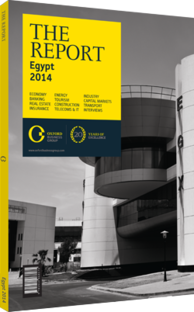Banking
The Company
Crédit Agricole Egypt is 60.5% owned by the Crédit Agricole Group, which has operations in 70 countries in Europe, the Americas, Asia and Africa. In September 2006, Egyptian American Bank merged its operations with Calyon Bank Egypt to become Crédit Agricole Egypt. As of December 2013, the bank had a 1.9% deposit market share in Egypt, down from 2.2% at the end of 2010. Since the January 2011 uprising, the bank’s asset base has shown a muted 4% CAGR, reflecting the group’s efforts to minimise exposure to risky assets as the risk rating for Egypt’s sovereign debt deteriorated. Over the past two years, the group has shifted its geographic focus, reducing exposure to sovereign debt in southern Europe. It also committed to disposing of non-core assets like Intesa Sanpaolo in 2012.
The Egyptian arm continued to show healthy profitability ratios, which along with its market positioning, have made Crédit Agricole one of Egypt’s top commercial banks. The stock’s main drawback is low liquidity, with market capitalisation of LE5bn ($710m) and free float at 24.7% of total outstanding shares.
In December 2013, the bank’s LTD ratio stood at 49%, with contribution to government Treasuries accounting for 28% of total deposits, a significantly lower level than the sector average of 51%. The bank’s conservative approach is reflected in its high interbank liquidity position, culminating in 23% of total assets – compared to the sector average of 11%. Retail loans represent 28% of total loans.
Despite the muted growth of its asset base, bottom-line growth was healthy and the bank capitalised on developments in Egypt’s economy. NIMs stood at 4.46% in 2013, compared to 4.03% the year before, as the bank took advantage of the high interest rate environment. As a result, net interest income grew 13%. Similarly, non-interest income rose 27% in 2013, triggered by foreign exchange gains following LE depreciation and increased activity in the forex market. Selling, general and administrative expenses grew 4% in 2013, in line with the group’s cost optimisation strategy, lowering the cost/income ratio to 43% from 49% the year before. Staggering income growth and moderate expenditure growth was reflected in the bottom line increasing 33% in 2013 to LE628m ($89.2m). The bank recorded a healthy ROA of 2.2% and ROE of 24.7% in 2013.
The bank’s NPLs increased significantly in 2013, to 4.5% of total loans, up from 1.9% in 2012. Corporate impaired loans represented 95% of total NPLs, reflecting the adverse business environment. In 2013, the bank recorded provisioning of LE146m ($20.7m), which was less than the corresponding increase in NPLs. The coverage ratio accordingly declined from 179% to 104%, hence the hampered asset quality. The Basel II capital adequacy ratio remained at 13.51% DEVELOPMENT STRATEGY: In its July meeting the Monetary Policy Committee of the central bank decided to tighten monetary policy, increasing the overnight lending rate by 100 bps to 10.25% and raising the deposit rate by 100 bps to 9.25%. Shifting to an expansionary policy is unlikely in the short-term on potential inflationary and liquidity pressures. The bank’s NIMs will remain elevated in the 4.5% range, assuming current utilisation levels are maintained.
Crédit Agricole Group has announced its intentions to focus on expansion efforts in European markets. Nevertheless, positive announcements by ratings agencies related to recent developments in the Egyptian economy could prompt the bank’s management to adopt a more aggressive strategy and regain lost market share, which on its own could imply a 24% increase in the bank’s deposit base.
Accelerated balance sheet growth and higher utilisation of funds are also anticipated to enhance NIMs, given the high interest rate environment in the country. An improved business environment would also boost asset quality. This could help to reduce provisioning pressure on the bank’s bottom line, which in turn should reflect positively on returns.
You have reached the limit of premium articles you can view for free.
Choose from the options below to purchase print or digital editions of our Reports. You can also purchase a website subscription giving you unlimited access to all of our Reports online for 12 months.
If you have already purchased this Report or have a website subscription, please login to continue.

